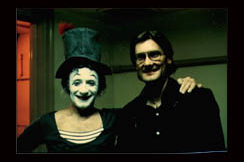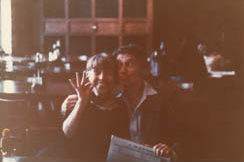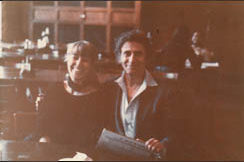Marcel Marceau
(1923-2007)
He taught the world about Mime
He taught us Mime

We Remember Our Teacher and Our Friend
The world has lost a great artist: Marcel Marceau! And we have lost a friend, mentor and teacher. For the last half of the 20th Century Marcel Marceau was Mime. But he was more than a mime because his talent transcended the Art of Mime to touch the world with his performance and creative genius. He shared that genius with his audience up to the end, showing that age holds no bounds.
Marcel Marceau was part of a long list of mimes, dating back to Ancient Greece. Before he took to the stage, the Art of Mime could be seen in the theatrical work of Max Reinhardt, Jean-Louis Barrault, and Etienne Decroux as well as with countless other mimes. And, in the 19th century, great mimes like Paul Legrand, and of course Jean-Gaspard Deburau. Mime was an art thriving when Marceau arrived on the scene. Marceau, however, took the art to a notch higher, maybe two notices higher.
The world knows of Marceau’s genius from his one-man shows with his partner Pierre Verry. Often over looked are the many full mime plays that he wrote, directed and performed. While his one-man shows, and Bip, offered great insights into the human condition, his mimodramas were plays that offered more. Some of these productions ran for over a year in Paris. Unfortunately, only a few of his mime plays toured. The Overcoat, toured to five cities in the United States in 1960-61.
The question has been asked: will Mime survive Marceau or will it die with him? Jean Dorcy posed this question in his 1960 book. We do not know for sure, but the answer is yes. Mime is too important an art to our world society to be lost, even if few recognize the art for what it is. With mime performances in every part of the globe from France to England, from Russia to Hong Kong, China to Chicago, it is difficult to see how it will not survive. Mime is alive and well today as it was when Marcel Marceau first entered the stage.
In 1846, the great French Mime Jean-Gaspard Deburau passed away. At that time all of Paris turned out and many thought the art would died with him, for he was Mime for his era. But Mime survived.
When Etienne Decroux began his life work with Mime, the art was beginning to stagnate, the times had changed and Mime was being left behind. Decroux changed the directions of the art and brought the art into the 20th century. And then, a hundred years after Deburau, in 1947, - Bip was born. Mime found a new Artist to capture the hearts of the people once again. With the legacy of students that Marceau has left from his two schools, Mime will continue to fascinate audiences around the world. We can only hope that the world need not wait until 2107 for the next keeper of the flame, the next Marcel Marceau.
Marceau is no longer with us – he lies in Paris with Deburau, Decroux, Jean Louis Barrault and Jacques Lecoq. While these giants of Mime lie in France, the rest of us can pay our respect and homage by supporting the true Art of Mime that Marceau nurtured for 60 years.
Having first studied with Marceau in Paris at his newly formed school, we were to take classes, assist in productions and have countless discussions over the years. From a teacher he became a mentor, helping us with performances, ideas and connections. Eventually, the three of us became very good friends.
We will forever remember the moments the three of us shared, these will be ours forever; the late night discussions, dinner at our home in Chicago (every time he came to Chicago), visits to his home, telephone calls when his brother died, the calls when he almost died in Russia, his concerns about our family, our concerns about his family, our talks about Pierre’s health and the loss of dear Margaret, helping each other with new ideas, talking about new productions, discussions about theories about Mime and private moments of great significance. Who now can we talk with about the history of Mime, the importance of Mime and the beauty of Mime? We never asked him for a letter of recommendation. Our friendship went beyond to a professional level. We were satisfied with his private comments of praise.
We could not be in Paris to say a final farewell to our dear friend. We take solace in knowing he is and shall be in our souls forever.
So we say farewell to our friend, his gestures are no more. His spirit is with us; his spiritual gestures lives on in our gestures. He gave us our art and he will live on in each gesture we make.



